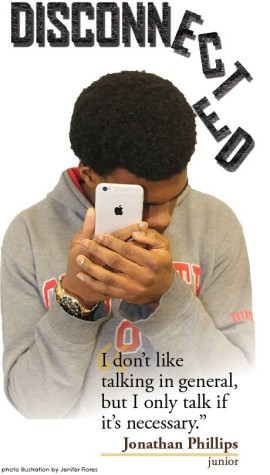Device dependence has teenagers feeling disconnected
 He shies away from people, constantly averting his eyes as to not meet another’s. His voice, barely audible, wavers in volume and confidence.
He shies away from people, constantly averting his eyes as to not meet another’s. His voice, barely audible, wavers in volume and confidence.
Jonathan Phillips speaks only when “necessary.”
In a new social divide where dependence on devices is growing, many people avoid face-to-face contact, instead seeking shelter behind a screen.
With three out of four teenagers owning a cell phone, according to National Public Radio, it is no surprise that this device dependence is so prevalent. In a 2010 study conducted by the Kaiser Family Foundation, teens were spend more than seven and a half hours a day watching television, surfing the Web, social networking, and using other media.
With so much time being spent interacting online, making phone calls, ordering food, and even speaking to people are now challenges to many teens who’d rather use a device.
Phillips, a junior, is one of many teens who experiences trouble speaking to people in person. “I don’t like talking in general,” Phillips said. As he struggles to find the words, he explains that talking to people online or through text is easier because he doesn’t talk really loud.
He describes himself as “awkward” when speaking to someone he doesn’t know that well, so he refrains from talking to people outside of his circle of friends, who describe him as talkative and louder than usual. He says besides his football and basketball teammates, and a few other close friends, he rarely acts that way.
With a soft voice and timid nature, sophomore Katherine Ortiz tends to let others speak for her. When she has to ask a question in class, or order food or movie tickets, Ortiz usually asks a friend or family member to do so for her.
“People scare me,” she said, explaining why she’s shy, “because they judge you.” Ortiz is another teen who prefers communicating through social media, such as Twitter or through text messages. She even ignores phone calls, feeling more comfortable to chat through texting.
Ortiz notices the differences in her behavior with people she’s comfortable with and others who intimidate her. For example, she said when she has to ask a teacher a question, she looks down, but when she meets one of her best friends, she’ll run up to them. When she’s communicating through text messages, she describes herself as “weird and funny,” definitely comfortable with the conversation.
Psychology teacher Ryan Berg has noticed this type of behavior in a lot of his students. Not only are teens more comfortable with communicating through devices, they depend on them for the quick availability of conversation.
“It’s a must-have culture,” he said, one that “expects instant gratification.”
Berg explains that the culture now is a “major shift” from when means of communication involved letters and travel on foot or horseback just to send a message. In addition, he describes how people’s attention spans nowadays are much shorter, as “everything’s about quick, quick, quick.”
“There’s an anxiety that comes in because we’re so accustomed to an instant response,” he said.
Michaella Booth, senior, is one who is “paranoid” when she doesn’t receive that instant response.
”I usually get (anxiety) when I text something long, or express my feelings … and don’t get a text back,” she said. “I think, ‘What could I have said differently?’”
She says she’s “shy as hell,” and is more inclined to speak through social media since “there’s not a lot of pressure.”
“You kind of hide behind the devices you’re using,” Booth said. Talking with close friends is easy, she says, but presenting in class is difficult to manage the transition from colloquial conservation to a more “educated” way of speaking. But the transition to depending on technology and being social may become a little easier. Berg says that although new teaching methods encourage students to work together and discuss the subject, technology is also being used to engage students.





